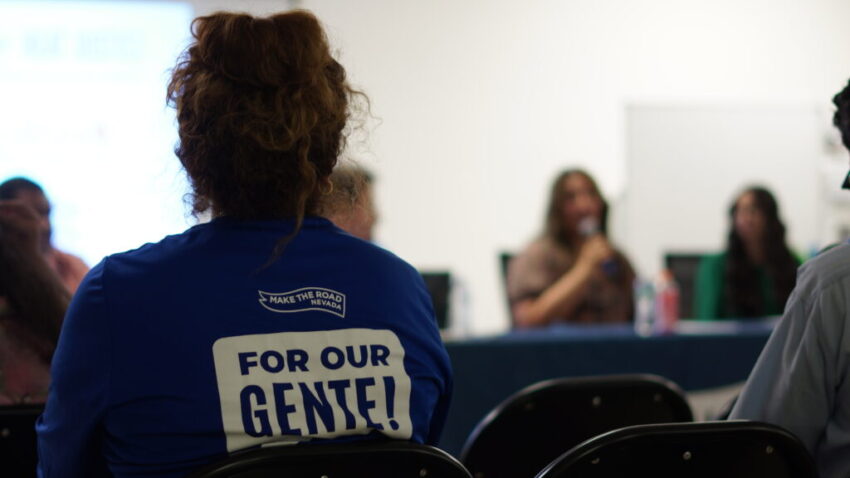Community members hear from panel of lawmakers and advocates about legislative losses and victories. (Photo courtesy of Make the Road Nevada)
In Assemblymember Cinthia Zermeño Moore’s North Las Vegas district the largest source of continuous turf and trees is a private golf course, the rest of her district is largely characterized by super heating concrete and asphalt.
During her campaign to be elected last year, Moore said she walked from door to door and heard story after story of residents who have been impacted by extreme heat and the lack of adaptation strategies in the state.
East Washington Avenue, which runs through Moore’s District 11, is an example of that lack of heat adaptation strategies, said Moore. Several bus stops along the route aren’t covered by any form of shade despite the city’s routine triple digit temperatures, while 20% of the district’s population depends on public transportation or walking.
Moore said there are several strategies local governments could take to help the public adapt to extreme heat, including extending operating hours for cooling stations, planting trees and installing water fountains along bus routes, and banning utility shuttoffs in the summer.
This year, Moore sponsored a bill to restrict utilities’ ability to shut off power due to nonpayment during extreme weather months. It would also require utilities to create payment plans for struggling customers who can’t make full payments.
The measure, Assembly Bill 456, didn’t get a hearing.
“One of the biggest expenses for people is rent, followed by utilities in the summertime. I was taken back by what I was hearing. At doors people were saying that they couldn’t pay their utility bill,” Moore said at an environmental justice panel organized by Make the Road Nevada, Chispa Nevada, and the Nevada Environmental Justice Coalition.
“The utilities are aware that I plan on bringing this back next session. It’s something that I’m going to be working on during the interim, and it is something that is needed in Nevada,” she continued.
Advocacy groups organized the Wednesday panel for “National Heat Week” to advocate for protections for workers exposed to extreme heat conditions.
Organizers celebrated several legislative victories this session, and also mourned legislative losses, like AB 456 the utility shuttoff bill.
Nevada Gov. Joe Lombardo did sign several environmental justice bills pushed by Make the Road Nevada, Chispa Nevada, the Nevada Environmental Justice Coalition, and other conservation groups.
One of those measures was Assembly Bill 96, which requires the state’s two most populous counties to actively address extreme heat through urban planning strategies, like creating public cooling spaces, public water access, cool building practices, and shaded areas in their development plans.
An environmental justice bill focused on worker protections also made the cut. Senate Bill 260 mandates Nevada OSHA to create regulations with clear protocols and employer responsibilities when wildfire smoke degrades air quality. The agency will have until next year to propose those regulations.
Jackie Spicer, the coordinator for the Nevada Environmental Justice Coalition, said once implemented Nevada will be one of the first states with OSHA regulations for wildfire smoke.
“We know in Nevada that wildfires are becoming more frequent, more severe and lasting longer due to hotter temperatures and the dry climate that we have in the West,” said Spicer.
“We now know it’s no longer appropriate to be sending people outside to be exposed to the toxic wildfire smoke,” she continued.
Nevada is also one of few states with worker protection for extreme heat after Nevada OSHA implemented regulations in April. The regulations require employers to create a written plan that provides workers with portable water, rest breaks, and a way to cool down during extreme heat.
Spicer said those regulations are an improvement compared to what Nevada had a year ago. But those regulations are limited and overly vague, giving employers a lot of wiggle room.
Nevada OSHA also has a limited number of case agents responsible for monitoring and reviewing worksites for extreme heat hazards, said Spicer.
“In Nevada we only have 40 OSHA inspectors statewide that are meant to cover every industry and every employer,” Spicer said.
“We’ll see whether or not these regulations are actually working and making a difference, or if there’s anything that we can do to improve,” Moore added.
Advocates emphasized the need for local government action and community mobilization to address extreme heat and wildfire smoke impacts, particularly on frontline communities and low-income workers.
“These issues have real impacts, and people feel them, and cannot afford to maintain the status quo, and we have to be taking as much action and change as possible to improve people’s lives so that we can continue to live here in the long term,” Spicer said.
Yanci Hill, a member of Chispa Nevada, described an event last year when a faulty air conditioner left her and her family in triple digit temperatures for a week. Cooling centers in the area didn’t allow them to bring their dogs and closed by 5 p.m.
“We had to put one of the dogs down because he had liver disease and couldn’t take the extreme heat,” Hill said in her native Spanish. “It was so painful. She was the one that slept with me and was with me all the time.”
Click this link for the original source of this article.
Author: Jeniffer Solis
This content is courtesy of, and owned and copyrighted by, https://www.nevadacurrent.com and its author. This content is made available by use of the public RSS feed offered by the host site and is used for educational purposes only. If you are the author or represent the host site and would like this content removed now and in the future, please contact USSANews.com using the email address in the Contact page found in the website menu.








